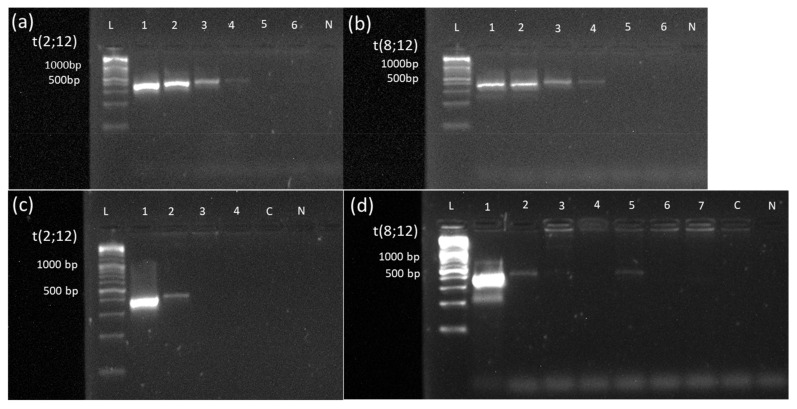Figure 5.
Sensitivity assessment of PCR-based MRD monitoring via a dilution series in cases #15 and #22 and Monitoring of MRD based on translocation t(2;12) and t(8;12) newly detected by OGM. A 10-logfold dilution series (100% to 0.001%) of the DNA sample from diagnosis into a healthy DNA sample was performed in cases #15 (a) and #22 (b). Specimen from the dilution series were subjected to breakpoint-spanning PCR with forward and reverse primers, as indicated in Table S1. In both cases, the PCR becomes negative at the 0.01% dilution step (Lane 5), indicating a sensitivity limit of detecting one blast within 1000 healthy cells (Lane 4). (c) MRD monitoring via breakpoint-spanning PCR in case #15. PCR was performed using forward and reverse primers (see Table S3), generating a product of 389 bp spanning the breakpoint of translocation t(2,12). Samples were collected at initial diagnosis (1), on day 28 after the start of treatment (2), after AI treatment (3), and after hAM treatment (4). PCR was positive at initial diagnosis and on day 28 after the start of treatment. Visual comparison of the band to the dilution series unraveled MRD in the range of 1%. At all other time points, as well as healthy control-DNA and negative control were negative in PCR. (d) MRD monitoring via breakpoint-spanning PCR in case #22. PCR was performed using forward and reverse primers (see Table S3), generating a product of 380 bp spanning the breakpoint of translocation t(8,12). Samples were collected at initial diagnosis (1), on day 28 after the start of treatment (2), after HAM treatment (3), after AI treatment (4), after hAM treatment (5), on day 60 (6), and on day 100 after SCT (7). PCR was positive at initial diagnosis, on day 28 after the start of treatment, and after hAM treatment. Healthy control-DNA and negative control were both negative. Abbreviations: 1 = 100% patient DNA; 2 = 10% patient DNA; 3 = 1% patient DNA; 4 = 0.1% patient DNA; 5 = 0.01% patient DNA; 6 = 0.001% patient DNA; C = control-DNA; chr = chromosome; L = length marker; N = negative control (H2O), t = translocation.

